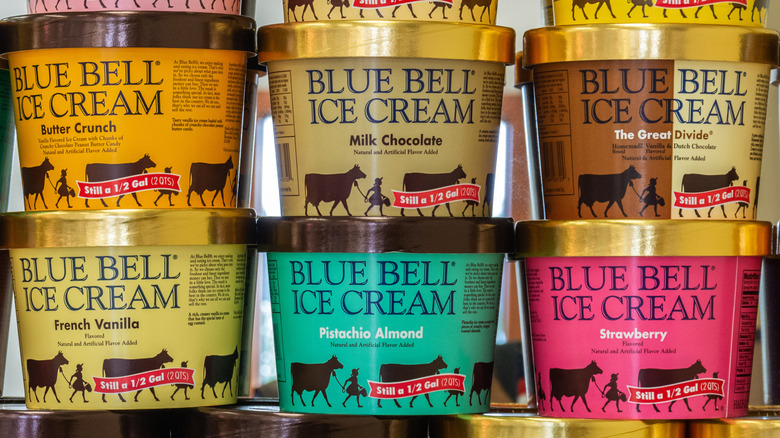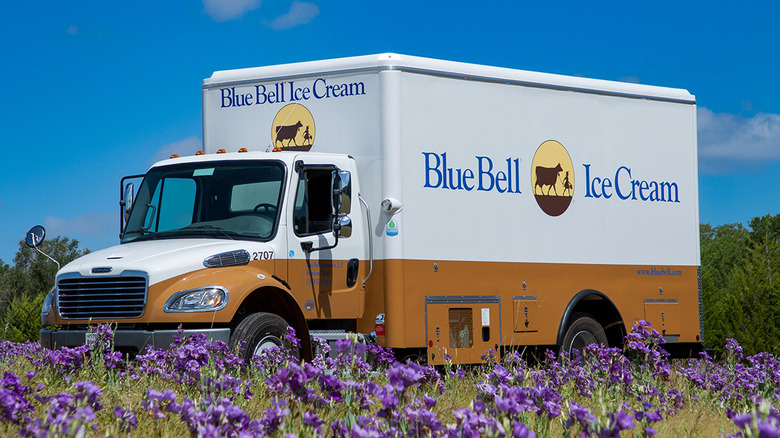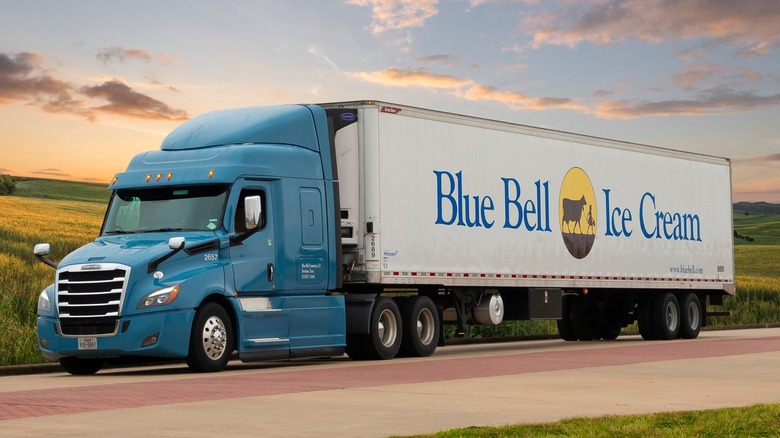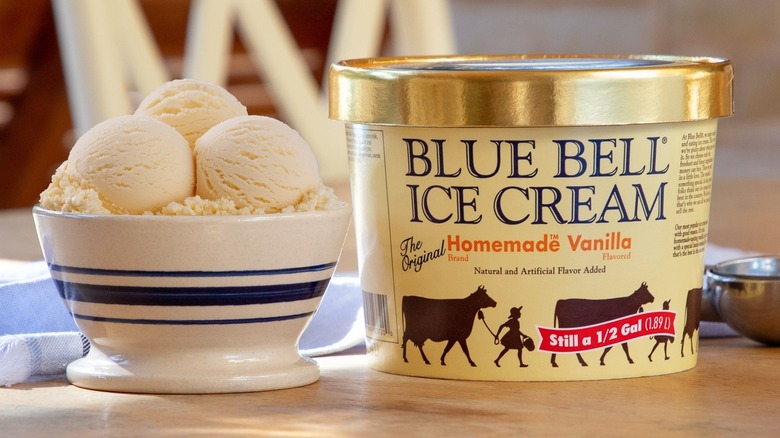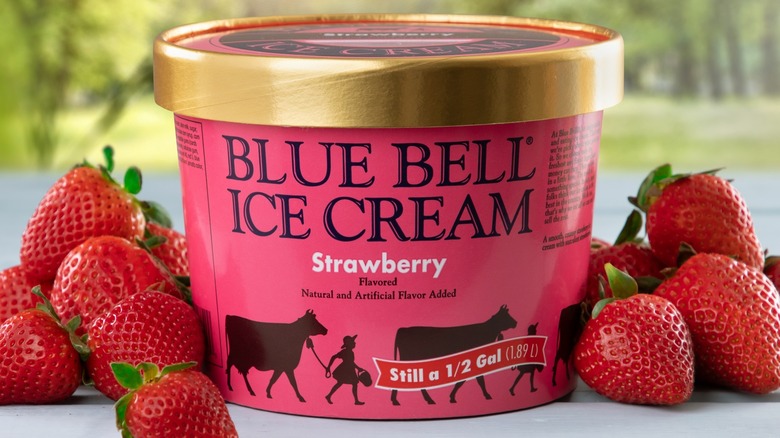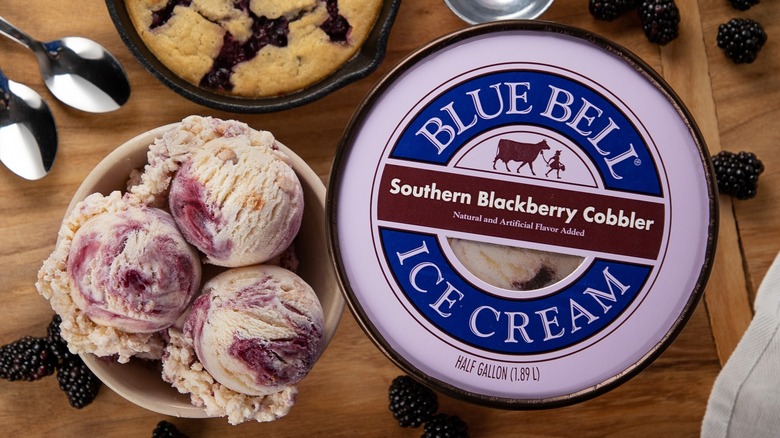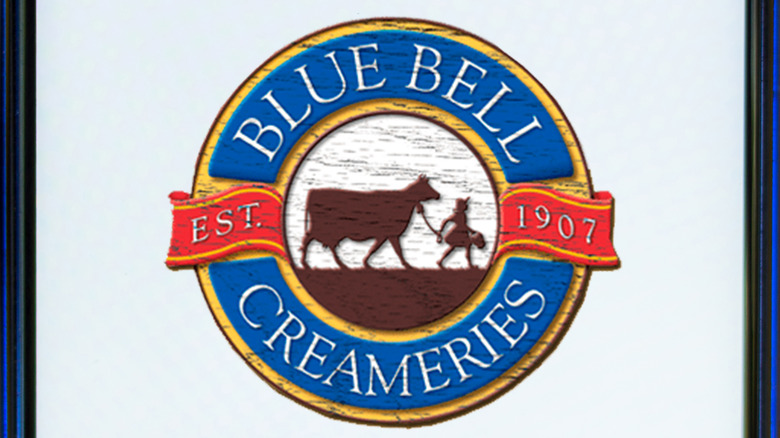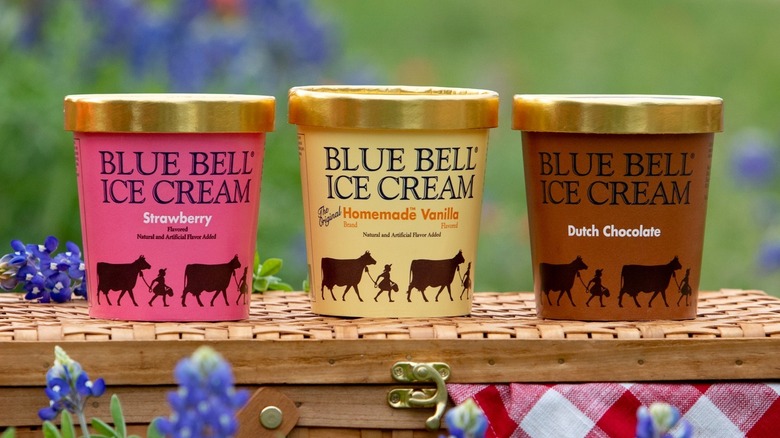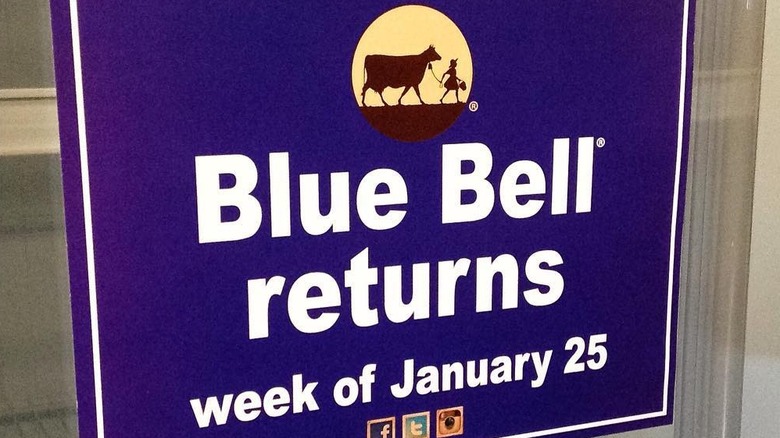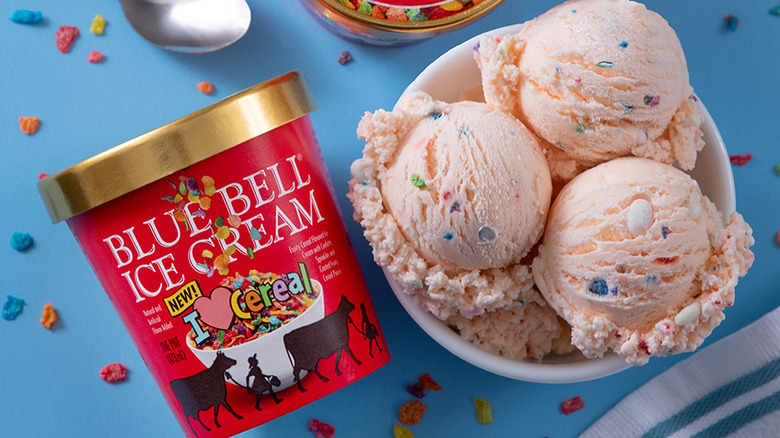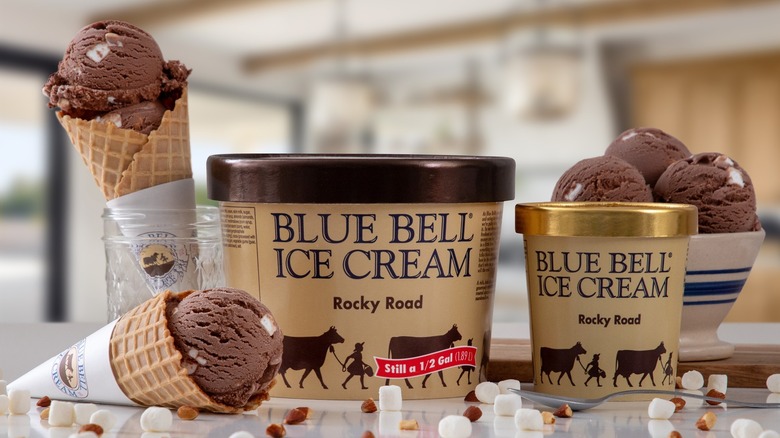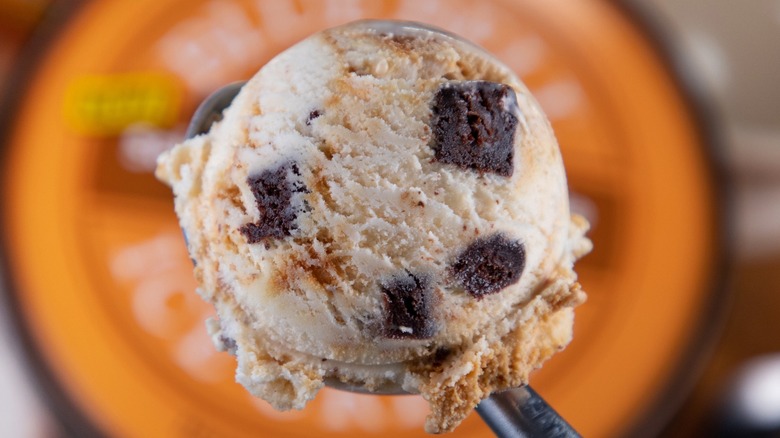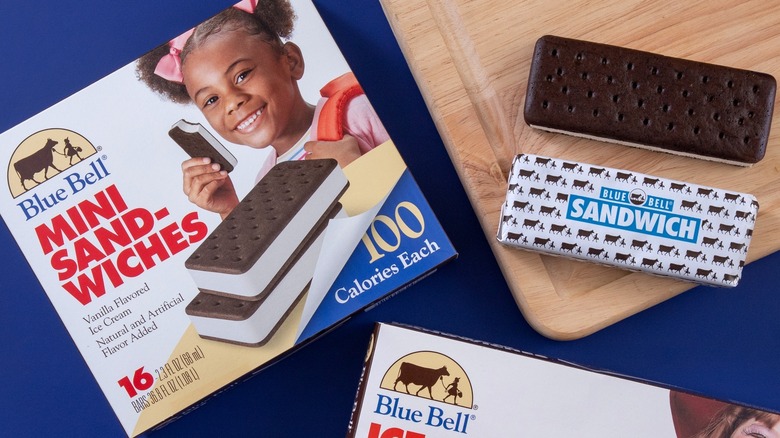Why Blue Bell Ice Cream Tastes So Incredibly Good
Few pleasures in life rival the sheer delight of indulging in a scoop of Blue Bell ice cream on a scorching hot summer day, except maybe for two scoops of Blue Bell ice cream. With its creamy texture, satisfying richness, a wide variety of flavors, and a legacy that spans over a century, Blue Bell has earned a special place in the hearts (and taste buds) of ice cream aficionados. Love for the brand is particularly present in the South; however, Blue Bell has begun to expand to various states across the country in recent decades, growing its dedicated fan base. But what exactly is it about this beloved frozen treat brand that makes its products taste so irresistibly delicious?
Mashed has rounded up all of the secrets behind the Texas-based creamery's delectable flavors, the company's time-honored traditions that have sustained its excellence, and the science that keeps those of us with a sweet tooth coming back for more.
Blue Bell's direct store delivery program results in great ice cream texture
One of the key aspects of a great scoop of ice cream is the texture. The best ice cream is creamy, rich, and smooth, without being too thick. Achieving the ideal ice cream texture is a feat in itself, but maintaining it during transit from the factory to grocery store freezers is another problem. Ed Kruse, a member of the family that operates Blue Bell, told the New York Times that ice cream's texture can be "ruined by any significant variation in temperature." Essentially, ice cream must be kept as close as possible to a stable temperature from the moment it's first frozen, otherwise melting and re-freezing will affect the texture of the product.
To mitigate this problem, Blue Bell uses what the company calls a "direct store delivery program." This protocol for transporting Blue Bell's frozen treats from the creamery to your local supermarket ensures that Blue Bell's products are transported in freezer trucks so customers get the freshest ice cream possible. Even more, the program ensures that only Blue Bell employees handle the products until it's safely on grocery store freezer shelves.
Blue Bell's slow growth proves it's focused on quality, not quantity
What started as a small business selling its ice cream to locals via a horse and wagon in the early 1900s has become a large company that sells its frozen desserts all throughout the southern part of the country. After more than 100 years of being in business, Blue Bell has expanded to be sold only in 23 states. Blue Bell, based in Texas, did not even start selling in states like Oklahoma and Louisiana until 1989. States like Alabama, Arkansas, Georgia, Kansas, Mississippi, and Tennessee were added to Blue Bell's territory throughout the 1990s. In the decades since, Blue Bell began to be available to ice cream lovers in additional states like Arizona, Colorado, Florida, Kentucky, Virginia, and more.
This growth may seem relatively slow compared to other national brands. However, it is a result of the company's dedication to quality and hands-on approach to delivering products to stores directly and only via Blue Bell employees. Impressively, the limited availability does not negatively affect the company's success. Although Blue Bell is sold in only a portion of the nation's supermarkets, it has become one of the country's top-selling ice cream brands nationwide.
Simple ingredients are key to Blue Bell's flavor
Any food product is only as good as the ingredients used to make it, and that is definitely true for ice cream. As its core, ice cream is made from a handful of ingredients. The sweet treat we know and love consists of a blend of cream or butterfat, milk, sugar, and flavorings... That's it! Whether ice cream is being made in a kitchen at home or in a factory for millions of customers, simplicity is key. Dedicated Blue Bell connoisseurs swear that the Texas-based creamery's products are "the best ice cream in the country." The company, which comes from modest beginnings, continues to make products nearly a century later from simple ingredients. For example, Blue Bell's Natural Vanilla Bean flavor is made with only seven ingredients, including milk, cream, sugar, skim milk, natural vanilla flavor, natural vanilla beans, and natural vegetable gums (guar, carob bean).
However, not everyone is a fan of Blue Bell's ingredients. Some have criticized the brand for using ingredients like high fructose corn syrup, cellulose gums, and vegetable gum. Regardless, lovers of the brand are loyal and appreciate the ice cream's delicious taste.
Blue Bell has a great year-round product selection
Ice cream fans' love for Blue Bell extends far beyond the classic flavors we expect from ice cream. One of the key reasons behind the brand's enduring popularity is the company's commitment to offering a wide and ever-evolving array of year-round flavors. Yes, the brand carries vanilla, chocolate, and strawberry, but it also carries unique yet simple variations on those iconic flavors, like Natural Vanilla Bean, featuring flecks of real vanilla; Chocolate Chip, with chunks of irresistible chocolate; and Strawberries & Homemade Vanilla, with fresh strawberries. In addition to twists on the classics, Blue Bell produces a slew of other one-of-a-kind creations such as Dr. Pepper Float, Banana Pudding, Black Walnut, and Butter Crunch.
The company understands that taste preferences can vary widely, and the company has mastered the art of catering to diverse palates by offering 24 different flavors as permanent staples. Whether you're craving the comforting nostalgia of Blue Bell's classic Homemade Vanilla, the zesty kick of Dutch Chocolate, or the whimsy of Cookie Two Step, there's a Blue Bell flavor to suit nearly every mood and occasion.
Seasonal and rotational ice creams are popular at Blue Bell
People's affection for Blue Bell reaches new heights throughout different times of the year thanks to its seasonal and rotational offerings. Blue Bell has perfected the art of capturing the essence of each season in a scoop of ice cream, creating a sense of anticipation and excitement among its customers.
From the vibrant burst of summer berries in Southern Blackberry Cobbler to the gooey decadance of Salted Caramel Brownie in the fall, these limited-time flavors evoke the spirit of the seasons. During the holiday season, Blue Bell offers a wide range of festive flavors like Eggnog, Christmas Cookies, Peppermint, and Peppermint Bark, making the company a staple at holiday get-togethers. In addition to seasonal offerings, the company has rotational releases of fun and exciting flavors — ranging from the whimsical Krazy Kookie Dough, packed with sugar cookie dough pieces in shades of green, blue, and pink — to the coffee fanatic's dream, Java Jolt, complete with coffee ice cream, dark chocolate flavored chunks, and a swirl of coffee fudge.
The company's seasonal and rotational delights change from year-to-year and season-to-season. This strategy not only keeps customers eagerly awaiting the next release but also fosters a sense of nostalgia and tradition, as fans associate Blue Bell with cherished seasonal moments. It's this ability to turn fleeting moments into unforgettable flavor experiences that makes Blue Bell a beloved choice for those who seek a taste of the seasons in every bite.
The creamery has experience crafting ice cream since 1907
What began as a small-town creamery in Brenham, Texas has evolved into one of America's most beloved and best-selling ice cream brands. Blue Bell was founded in 1907 as the Brenham Creamery Company and has built a storied history spanning over a century. The company's longevity and success can be attributed to its unwavering commitment to quality and tradition, earning a sterling reputation among ice cream enthusiasts.
The company's rich experience in crafting ice cream for more than 100 years has given it ample time to perfect its recipes, develop a wide range of flavors, and establish a deep understanding of what consumers truly crave. Blue Bell's ability to blend ongoing innovation with a commitment to producing timeless classics has resulted in a product line that caters to a broad spectrum of tastes. Moreover, the company's long history as a Southern staple has fostered a sense of nostalgia and tradition, creating a strong emotional connection with its customers. Many people have fond childhood memories of enjoying Blue Bell ice cream, and this nostalgia keeps them loyal to the brand.
Blue Bell ice cream sparks Southern nostalgia
Southern nostalgia is an integral component of Blue Bell's enduring success. The brand is tightly woven within its customers' cherished memories and the pride customers feel for their regional identity. The brand's Texas roots and commitment to preserving time-honored traditions resonate with consumers, invoking a sense of comfort and familiarity. Blue Bell has a unique ability to evoke memories and moments from generations past with its iconic flavors like Homemade Vanilla and Dutch Chocolate. For many, Blue Bell ice cream captures the essence of Southern hospitality. This nostalgia creates a powerful emotional connection with customers, which fosters loyalty and makes Blue Bell a cultural symbol.
Recently, the brand posted on its Instagram asking for customers to share their memories of the first time they ever had the Texas-born ice cream. From sharing cherished memories with their grandparents to getting through chemotherapy treatments, customers flocked to share the moments that made them Blue Bell fans. One customer said, "I'm from Texas so it was probably in the womb."
When it comes to Blue Bell, enjoying a scoop of their ice cream is more than an act of having dessert — it becomes a nostalgic journey.
The company enhanced safety measures following listeria outbreak in 2015
The 2015 Blue Bell listeria outbreak was a significant setback for the brand, leading to a widespread recall of all its products and a temporary break in production. Listeria in some Blue Bell products was linked to several illnesses and three tragic deaths. The company faced severe public health concerns and damage to its reputation. To recover, Blue Bell undertook a comprehensive overhaul of its facilities and production processes, implementing stringent food safety measures. They worked closely with health authorities to ensure compliance with safety standards and conducted rigorous testing to eliminate any traces of listeria. Their transparency in addressing the issue and their dedication to prioritizing consumer safety helped regain trust.
Blue Bell's recovery strategy included a phased relaunch of its products in regions where it was most popular, gradually expanding distribution as safety measures were successfully implemented. Their loyal customer base played a pivotal role in their resurgence, demonstrating unwavering support throughout the ordeal. During the pause in production, some customers even turned to the black market to purchase their favorite Blue Bell ice cream. While the listeria outbreak was a challenging chapter in its history, Blue Bell's steadfast dedication to quality, quick and thorough response to the issue, and the loyalty of its customer base ultimately helped it not only recover but also maintain its status as a best-selling brand in the ice cream industry.
Blue Bell takes flavor suggestions from customers
How does Blue Bell create such innovative and delicious flavors? In part, its customers. The company's public relations manager, Lauren Lewis, said that "a majority" of the company's ideas for new flavors of ice cream come from consumers. Customers will email and call the company to share their ideas of what they believe should be Blue Bell's newest flavor creation should be. These creative ideas often stem from customers' family recipes for desserts. Each year, all of the customer ideas, internal concepts, employee ideas, and requests for returning flavors are then moved on to Blue Bell's internal research and development team. Employees determine which ones will become a part of the company's lineup of flavors.
From the inception of a new flavor to getting the ice cream on grocery store freezer shelves, the process takes anywhere from two to three years. That's because the company must source producers of ingredients and ensure there will be a stable supply of high-quality ingredients to create enough product that meets the demand for new flavors.
Fresh milk is used in every batch of Blue Bell ice cream
According to the Texas State Historical Association, the company began as Brenham Creamery Company, a dairy cooperative, and in the mid-'90s, "Bluebell continue[d] to obtain its raw materials, including milk and cream, from large cooperatives of dairy farmers, primarily in Texas." The company has four production facilities, with two in Brenham, one in Sylacauga, Alabama, and one in Broken Arrow, Oklahoma. New York Times reports that the milk is sourced from "50,000 cows from Jersey and Holstein herds on farms within 200 miles of Brenham." Historically, the company has boasted about working closely with dairy farmers in the region to ensure a consistent and high-quality supply of fresh milk and cream, which are essential ingredients in ice cream production. Moreover, the Kruse family has cited its fresh milk as one of the reasons the company has not expanded nationwide as quickly as some might expect a successful brand like Blue Bell to do.
"The milk we use is so fresh it was grass only yesterday," the Kruses told the New York Times in 2006.
To make sure the milk is of the best quality, every batch of milk is tested for flavor.
Blue Bell ice cream has a butterfat content around 13%
Not every bucket of ice cream you see on your local grocer's freezer shelves is, in fact, ice cream. Many products in the freezer aisle are labeled as "frozen dairy dessert." So, what's the difference? Ice cream is made with a specific ratio of milk, cream, sugar, and sometimes egg yolks, which gives it the rich and creamy texture we all love. In contrast, "frozen dairy dessert" contains less butterfat and incorporates additional stabilizers and emulsifiers, resulting in a texture that is less creamy and more icy. The term "frozen dairy dessert" is sometimes used to label products that do not meet the specific standards and ingredients required for labeling as "ice cream." To be legally considered ice cream, the product must contain at least 10% milk fat.
Blue Bell ice cream has a butterfat content of around 13%, making it richer in flavor than some other brands. This higher milk fat content also means more weight in the product itself. For instance, a half-gallon of Blue Bell ice cream weighs around 52 ounces, compared to Breyers, which weighs around 40 ounces. Although Blue Bell's butterfat content is higher than some of its competitors, it's not quite as high as others, like Häagen-Dazs. The difference in butterfat helps determine the precise texture and richness of a brand of ice cream, which could help explain why so many are drawn to Blue Bell specifically.
The brand offers a variety of products
Blue Bell's expansion beyond traditional ice cream formats (such as half-gallons and pints) into additional frozen desserts, has been a big factor in the brand's success. It offers customers a variety of ways to enjoy frozen treats, regardless of what their preferences may be.
The Texas creamery offers a variety of popsicle flavors, making for a refreshing treat during the hot summer months. In addition, the company creates a range of frozen novelties. Popular varieties include ice cream sandwiches, chocolate covered ice cream bars, and miniature sundae cups, in which Blue Bell ice cream is swirled with sundae toppings and sauces. Blue Bell also crafts creamy and fruity sherbet in flavors like lime, orange, and rainbow. In addition, the brand makes a "no added sugar" variety of vanilla ice cream.
This diversification has helped Blue Bell to meet varying consumer preferences and extend its appeal, making the brand even more flexible and appealing.
